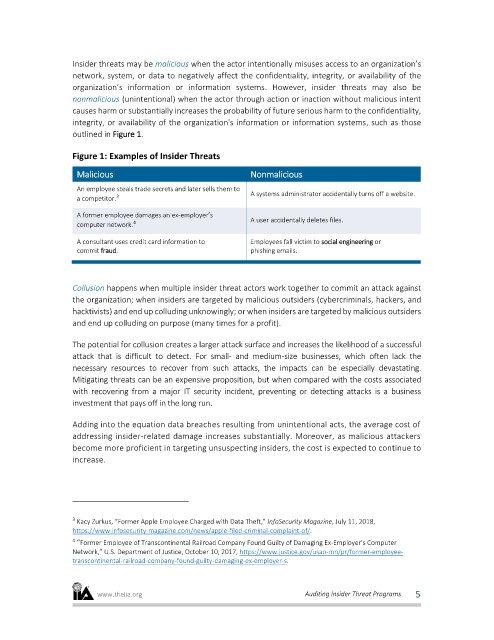Page 372 - ITGC_Audit Guides
P. 372
Insider threats may be malicious when the actor intentionally misuses access to an organization’s
network, system, or data to negatively affect the confidentiality, integrity, or availability of the
organization’s information or information systems. However, insider threats may also be
nonmalicious (unintentional) when the actor through action or inaction without malicious intent
causes harm or substantially increases the probability of future serious harm to the confidentiality,
integrity, or availability of the organization's information or information systems, such as those
outlined in Figure 1.
Figure 1: Examples of Insider Threats
Malicious Nonmalicious
An employee steals trade secrets and later sells them to
3
a competitor. A systems administrator accidentally turns off a website.
A former employee damages an ex-employer’s A user accidentally deletes files.
4
computer network.
A consultant uses credit card information to Employees fall victim to social engineering or
commit fraud. phishing emails.
Collusion happens when multiple insider threat actors work together to commit an attack against
the organization; when insiders are targeted by malicious outsiders (cybercriminals, hackers, and
hacktivists) and end up colluding unknowingly; or when insiders are targeted by malicious outsiders
and end up colluding on purpose (many times for a profit).
The potential for collusion creates a larger attack surface and increases the likelihood of a successful
attack that is difficult to detect. For small- and medium-size businesses, which often lack the
necessary resources to recover from such attacks, the impacts can be especially devastating.
Mitigating threats can be an expensive proposition, but when compared with the costs associated
with recovering from a major IT security incident, preventing or detecting attacks is a business
investment that pays off in the long run.
Adding into the equation data breaches resulting from unintentional acts, the average cost of
addressing insider-related damage increases substantially. Moreover, as malicious attackers
become more proficient in targeting unsuspecting insiders, the cost is expected to continue to
increase.
3 Kacy Zurkus, “Former Apple Employee Charged with Data Theft,” InfoSecurity Magazine, July 11, 2018,
https://www.infosecurity-magazine.com/news/apple-filed-criminal-complaint-of/.
4 “Former Employee of Transcontinental Railroad Company Found Guilty of Damaging Ex-Employer’s Computer
Network,” U.S. Department of Justice, October 10, 2017, https://www.justice.gov/usao-mn/pr/former-employee-
transcontinental-railroad-company-found-guilty-damaging-ex-employer-s.
www.theiia.org Auditing Insider Threat Programs 5

